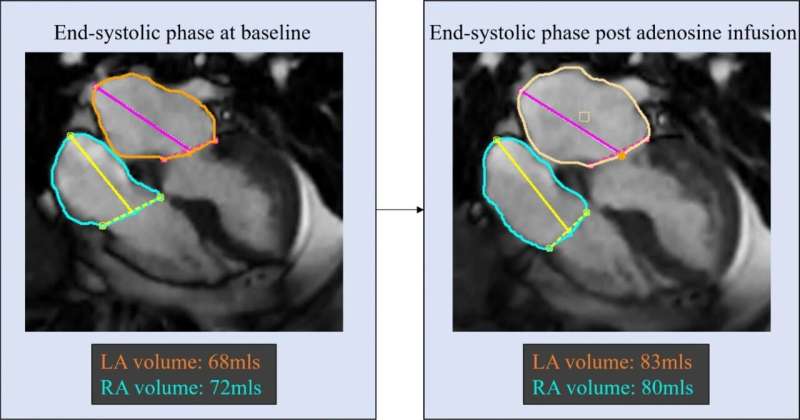This article has been reviewed according to Science X's editorial process and policies. Editors have highlighted the following attributes while ensuring the content's credibility:
fact-checked
trusted source
proofread
The technology that can detect rapid pressure changes inside your heart

Researchers at the University of East Anglia have used cutting-edge imaging technology to measure acute pressure changes inside the heart.
The state-of-the-art technology uses magnetic resonance imaging (MRI) to create detailed images of the heart.
Using the new technology, the team discovered that pressure inside the heart goes up when given a specific medication for testing the heart's blood flow.
They also found out why this medication called adenosine, makes patients breathless during the test.
The team say their findings could help doctors better diagnose and monitor patients with heart disease and heart failure.
Lead researcher Dr. Pankaj Garg, from UEA's Norwich Medical School, said, "When patients present with symptoms of heart disease, doctors use a special test called heart MRI to take detailed pictures of the heart and see how well it is working."
"Sometimes, patients are given a special medication called adenosine during the heart MRI test to see how blood flows through the heart, and it can cause breathlessness."
"We wanted to better understand the way that the heart functions, and why patients become breathless when given adenosine."
The UEA team worked with researchers at the University of Leeds and studied 33 patients referred for a stress cardiac MRI.
This test is performed to help evaluate the blood flow in the heart arteries, looking for blockages.
The research team took pictures of the patient's heart when it was resting and when it was working hard after being given adenosine.
"Adenosine mimics the effect of exercise on the heart while the patient is lying down on the scanner," said Dr. Garg, "And we discovered why it makes patients get out of breath."
Postgraduate researcher Hosamadin Assadi, also from UEA's Norwich Medical School, said, "We looked at the top chamber of the heart, called the left atrium, and also looked at the lower part of the heart, called the left ventricle."
"We used advanced software to measure and study the heart, and we also estimated the pressures inside the heart before and after giving the medication."
"Our study shows that after giving patients adenosine, the heart's left atrium got bigger really fast—just before the blood flowed out."
"This is important as it shows that the previously published heart MRI pressure model is adaptable to acute changes in the heart and can be more broadly used to diagnose and monitor heart disease—in particular heart failure."
"We also found that a measure called LVFP, which tells us about the pressure inside the heart, went up when the heart was working hard."
Dr. Garg's previous work showed that a 4D heart MRI scan can create detailed flow images of the heart, and how this non-invasive imaging technique can measure the peak velocity of blood flow in the heart accurately and precisely.
The scan takes just six to eight minutes and can provide precise imaging of the heart valves and the flow inside the heart in three-dimensions, helping doctors determine the best course of treatment for patients.
"This work strengthens the notion of using heart MRI to measure pressures inside the heart," added Dr. Garg.
The study is published in the journal BMC Cardiovascular Disorders.
More information: Pankaj Garg et al, An acute increase in Left Atrial volume and left ventricular filling pressure during Adenosine administered myocardial hyperaemia: CMR First-Pass Perfusion Study, BMC Cardiovascular Disorders (2023). DOI: 10.1186/s12872-023-03230-x





















